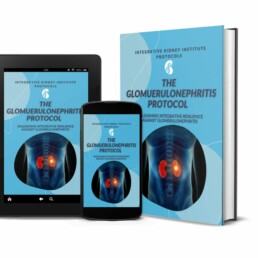Chronic Kidney Disease (CKD) is a progressive condition where the kidneys lose their ability to filter blood effectively over time. This can lead to a buildup of waste products in the body, causing various health issues. Early detection of CKD is crucial for several reasons, including slowing disease progression, improving quality of life, and reducing the risk of complications. This blog post will delve into the importance of early detection of chronic kidney disease, how it can be achieved, and the potential outcomes of timely intervention.
By Majd Isreb, MD, FACP, FASN, IFMCP
Understanding chronic kidney disease
Chronic Kidney Disease is often silent in its early stages, making it particularly dangerous. Many individuals do not experience symptoms until their kidney function has significantly declined. CKD is commonly caused by diabetes and high blood pressure, which can damage the kidneys’ filtering units, leading to reduced kidney function. This is followed by autoimmune kidney diseases (glomerulonephritis).
Understanding the Stages of Chronic Kidney Disease
Chronic Kidney Disease is categorized into five stages based on the degree of kidney damage and function. These stages are determined by measuring the glomerular filtration rate (GFR), which assesses how well the kidneys are cleaning the blood.
- Stage 1: Kidney damage with normal or high GFR (≥90 mL/min/1.73 m²). At this stage, the kidneys are still functioning well, but evidence of kidney disease is detected through other means, such as protein in the urine or physical damage to the kidneys.
- Stage 2: Mild loss of kidney function (GFR of 60-89 mL/min/1.73 m²). Kidney damage is more apparent, but the kidneys still function reasonably well.
- Stage 3: Moderate loss of kidney function, subdivided into stages 3A (GFR of 45-59 mL/min/1.73 m²) and 3B (GFR of 30-44 mL/min/1.73 m²). Symptoms may become more noticeable, including fatigue, fluid retention, and changes in urination patterns.
- Stage 4: Severe loss of kidney function (GFR of 15-29 mL/min/1.73 m²). At this stage, the damage is more severe, and the risk of kidney failure increases. Symptoms can include more significant fluid retention, urinary changes, and other complications affecting overall health.
- Stage 5: Kidney failure (GFR <15 mL/min/1.73 m²) or end-stage renal disease (ESRD). At this final stage, the kidneys have lost nearly all their ability to function effectively, requiring dialysis or kidney transplantation for survival.
Early detection of CKD, ideally in stages 1 or 2, allows for interventions that can slow the progression of the disease and significantly reduce the risk of advancing to end-stage renal disease. Understanding these stages emphasizes the importance of regular screening and monitoring for those at risk of CKD.
Join us to end the kidney disease epidemic
The Importance of early detection
Slowing disease progression
Early detection of CKD allows for interventions that can slow the progression of kidney damage. By managing underlying causes, such as diabetes and hypertension, individuals can significantly reduce the rate at which kidney function declines. In fact, I truly believe that early intervention with lifestyle modifications and an integrative approach can halt or even reverse CKD.
Reducing complications
CKD can lead to complications, including cardiovascular disease, anemia, bone disease, and electrolyte imbalances. Early detection and management of CKD can help prevent or mitigate these complications, improving overall health outcomes and quality of life.
Enhancing quality of life
Early intervention in CKD can significantly enhance the quality of life for individuals with the disease. By managing symptoms and complications early, individuals can improve their lifestyle to maintain a more active and fulfilling life despite their condition.
Economic benefits
The early detection of CKD can also have significant economic benefits. By reducing the need for more intensive treatments and managing complications early, healthcare costs associated with advanced CKD and its treatments can be significantly reduced.
Indeed, current models for early detection of CKD suggest that screening individuals at high risk, such as those with hypertension or diabetes, is economically sound. This is based on cost-effectiveness thresholds ranging between $50,000 and $150,000 USD per quality-adjusted life year gained.
How to achieve early detection
Early detection of CKD involves regular screening for individuals at risk, including those with diabetes, hypertension, a family history of kidney disease, or other risk factors. Screening tests typically include blood tests for serum creatinine (used to estimate glomerular filtration rate (GFR)), and urine tests for albumin (a protein that can indicate kidney damage).
The Kidney Disease: Improving Global Outcome (KDIGO) recommends screening for early detection of CKD in these individuals:
- Persons with hypertension, diabetes, or cardiovascular disease.
- Other high-risk individuals or populations based on comorbidities, environmental exposures, or genetic factors.
KDIGO also recommends utilizing the combination of measurements of serum creatinine, serum cystatin C, and urine albumin as the standards for early detection of CKD.
Encouraging at-risk populations to get screened
Awareness campaigns and healthcare policies should focus on encouraging at-risk populations to undergo regular screening for CKD. This can involve educational efforts to inform the public about the risks of CKD and the benefits of early detection.
Integrating screening into primary care
Integrating CKD screening into routine primary care visits can help ensure that individuals at risk are identified early. Primary care providers play a crucial role in identifying at-risk individuals and initiating screening and follow-up care.
At-home testing for early detection of CKD
At-home testing for the early detection of CKD offers a convenient and accessible way for individuals to monitor their kidney health, especially those at high risk due to conditions like diabetes or hypertension. These tests typically involve the analysis of a urine sample for markers such as protein or albumin, which can indicate kidney damage.
Quality at-home measurements of BUN and creatinine have recently become commercially available and affordable. This testing allows for the estimation of GFR and early detection of the decrease in kidney function.
By facilitating early detection, at-home tests can play a crucial role in managing and slowing the progression of CKD, allowing for timely medical intervention and lifestyle adjustments.
Get a 25% discount on Kidney testing with promotional code IKI25.
The bottom line on early detection of chronic kidney disease
Early detection of chronic kidney disease is critical to managing the disease and improving outcomes for individuals at risk. Through regular screening, management of underlying conditions, and early intervention, the progression of CKD can be slowed (or even halted), complications can be reduced, and the quality of life for those with the disease can be significantly improved. Healthcare providers, policymakers, and individuals must work together to prioritize early detection and management of CKD to achieve these goals.










